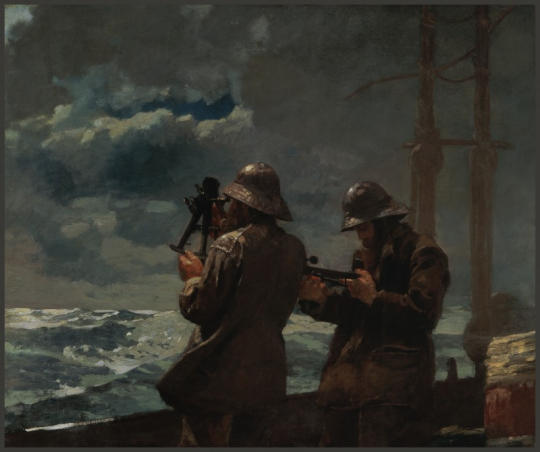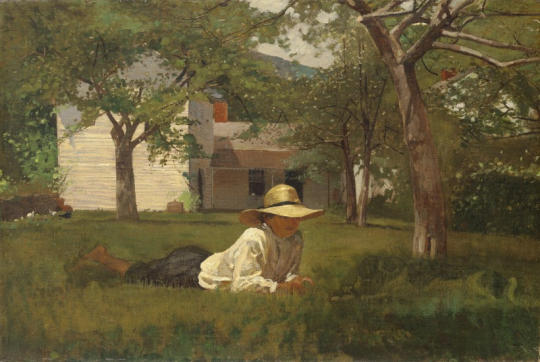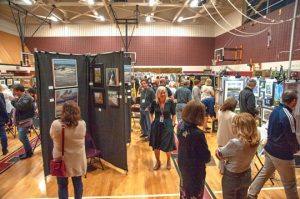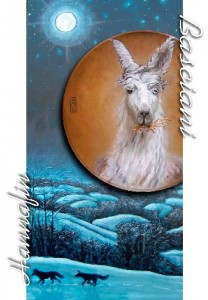The newest Brandywine River Museum of Art exhibition Winslow Homer: Photography and the Art of Painting, is a fascinating show that explores the creative growth of artist Winslow Homer. Many experts revere Homer as America’s finest painter and America’s first modern painter. As you enter the exhibition from the right doorway through to the explosive final paintings at the exit, you can witness the transformation from an able illustrator to an unparalleled master.
Homer’s early artistic life was as an engraver at the age of eighteen. At the time, 1860s, engravings generally were taken from photographic subjects, and used for magazines and newspapers. At the early part of this exhibition, the photographs really take center stage. We see photographs by Mathew Brady and Alexander Gardner of Abraham Lincoln and his inauguration day. Homer’s engravings are quite lifeless in comparison to the photographs, but served their purpose in reportage. It is really quite humbling to be inches in front of a photograph of Abraham Lincoln; while in the gallery I heard a visitor gasp, “Is that Lincoln! Oh my gosh!” Likewise, the other photographic images bring us vividly to the times and place. I was entranced by a small photograph by Henry P. Moore G’wine to de Field that was really a snap shot of slaves by the roadside on their way to work. I’ve never seen an image of slavery that was not posed and intended to illicit a response, and this snapshot gave me an unexpected window.
After two years with an engraving firm, Homer was sent to various spots during the Civil War as an artist correspondent for Harper’s Weekly, which is like our Time Magazine today. He would sketch on site and then go back to New York to make the final etching or paintings. His sketches mostly concern the day to day life of the soldier in the camp and do not stray much to the gruesomeness of the battlefield. They are observations of very human interactions in rather grimy conditions. At this point Homer was in his very early 20s, and along with the Civil War reportage, he was making more fashionable images of day to day scenes that are not indicative of a stellar artistic career ahead.
Homer’s first finished oil painting was Sharpshooter, and this exhibition has the Harper’s Weekly wood engraving that Homer made from the painting. Homer proudly put Sharpshooter in a gallery and said that if this first painting didn’t sell for $60 then he was going to pack it in as an independent artist and just sign on with Harper’s as a staff engraver. Happily, the painting sold immediately, he received the confidence booster he needed, and never looked back. Interestingly, like with many starting artists, the painting was actually bought by his elder brother in secret. Homer’s tight knit family encouraged him from the very start and throughout his long career.
His mother, Henrietta Benson Homer, was a very accomplished water color painter, and this exhibition shows beautiful examples of her insect and flower studies. In the beginning of his painting career, Homer use water color as a sketch medium to secure the light or memory of a scene, and in mid-life he often used watercolor as a medium of choice for a final work. Back in the 1860s, water color as painting was relegated for use by women and amateurs. In 1866 Winslow Homer is credited with making water color an accepted painting medium by the American Society of Painters.

Winslow Homer, The Fisher Girl, 1894, oil on canvas, Mead Art Gallery, Amherst College. Gift of George D. Platt, Class of 1893
As the exhibition unfolds, you see more images of people set amongst great expanses of land or sea. The people, mostly young, are seen doing everyday tasks, just like the subject matter that he zeroed in on for his Civil War and pastime Harper’s images. Average people in average dress, quintessentially American working class set in American farm, forest or seascapes. As his paintings unfold, the people in them have more volume and play a greater part in the composition and power of the image. At the start of his carrier the people depicted were more caricatures, parts of a scene that needed describing; like a photo snap shot, the early drawings and paintings were an intimate view of a scene that largely took their style from the other popular illustrators at Harper’s. In the late 1860s through 80s, Homer’s painting style change from a scenic time capsule, to painting of more mythic proportions.
In the 1880s the sea took on a more constant presence in his work. The immense power of the sea, the people that worked on the sea and those who were affected by it, became the stage for his subsequent major works. In the exhibition, you can see water coming more and more into his subject matter. He lived the last 30 or so years of his life on the remote seaside area of Prout’s Neck in Maine, taking care of is elderly parents and painting the coastline.
One of the many things I like about this exhibition is that it focuses on the growth of this artist, without drawing unnecessary attention to possible influences (impressionists, Japanese woodcuts, Whistler etc) because even though Homer did visit Europe many times, he was a very solitary person who pursued his own vision with steadfast will. He enjoyed isolation. He was mostly self-taught, and in this exhibition, you can see him pushing himself to create images completely his own.
His last images in the show are monumental, without overt sentimentality, historical references, or flashiness. Winslow Homer’s iconic, Eight Bells, still takes my breath away. You can feel the cold and wet, and the vastness of the sky and ocean, juxtaposed with two steady seamen calmly and efficiently doing their noon-time measurements, that they will repeat throughout the day. The painting is large scale, and we can’t see the features of the sailors, so they become generalized and the image as a whole is more mythic, and universal humanity working. That the sailors are trying to measure such vastness, could be said to be ironic in its futility, but the artist shows their efforts to be noble and admirable. Much like the artist himself taking a lifetime in dauntingly trying to portray the immensity of the sea, he heroically keeps at it, doing the best he can.

The final painting in the show is Artist’s Studio in an Afternoon Fog, from 1894, and is expertly hung just around the corner before the exit, just after a symphony of large ocean paintings. It has a very straightforward composition, minimal palette of colors and brushwork. There is an indication of structures silhouetted against a dark sky with a suggestion of surf and beach in front. It is a blockbuster of a piece. When you see Homer’s steady growth as an artist, his solidification of his personal viewpoint and painting style, his mammoth, famous seaside images, and then Artist’s Studio in an Afternoon Fog, it truly is a revelation. It is no wonder that so many applaud Winslow Homer as America’s first modern artist. I certainly felt like clapping at the end of the exhibition.
This exhibition is terrific for viewers of all ages, with many varied items of interest in addition to some of America’s finest paintings. To the beginning artist, this exhibition should be a wonderful encouragement, to work hard, keep at it, stay true to yourself and eventually it will all come together. Winslow Homer: Photography and the Art of Painting, is open now through February 17, 2019 at The Brandywine River Museum of Art.
About Lele Galer
Lele Galer is an artist who has chaired numerous art shows, taught art history and studio art, public art and has chaired, written and taught the Art in Action Art Appreciation series for the UCFD schools for the past 12 years. She worked at the Metropolitan Museum of Art, and wrote for the Associated Press in Rome. She has been dedicated to Art History and art education for most of her adult life. Lele and her husband Brad own Galer Estate Winery in Kennett Square.
- Web |
- More Posts(141)





Comments